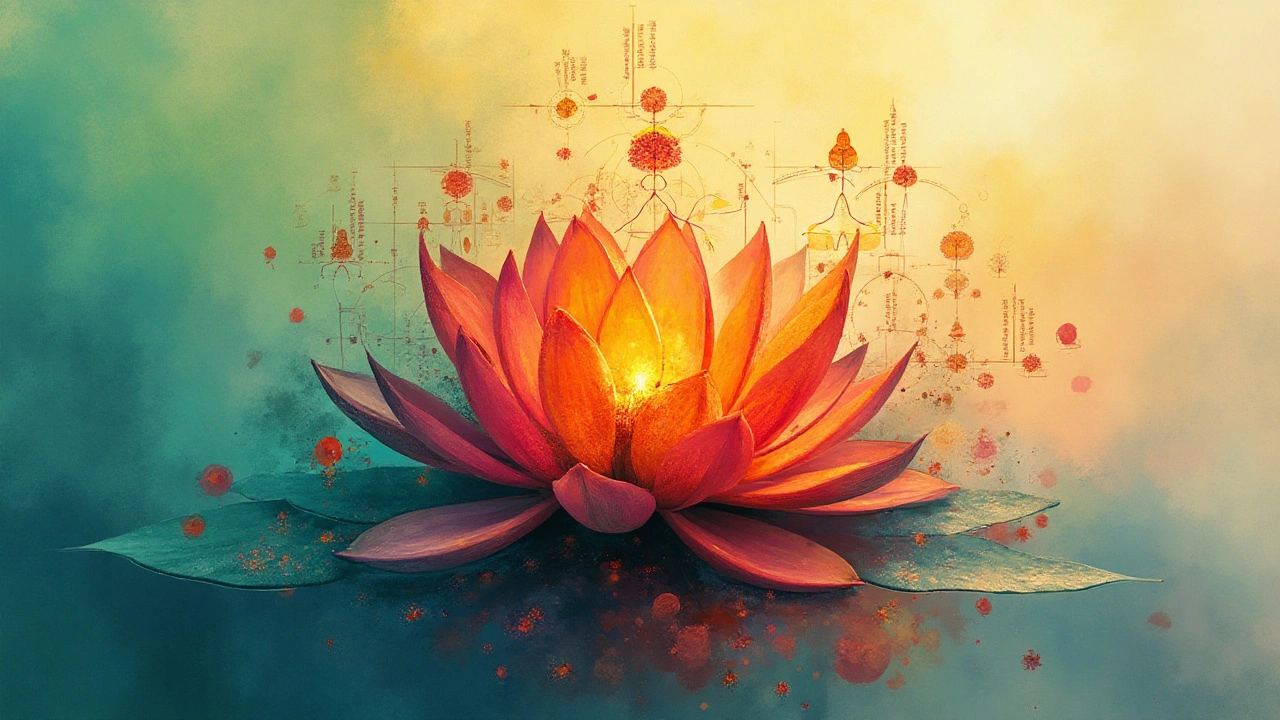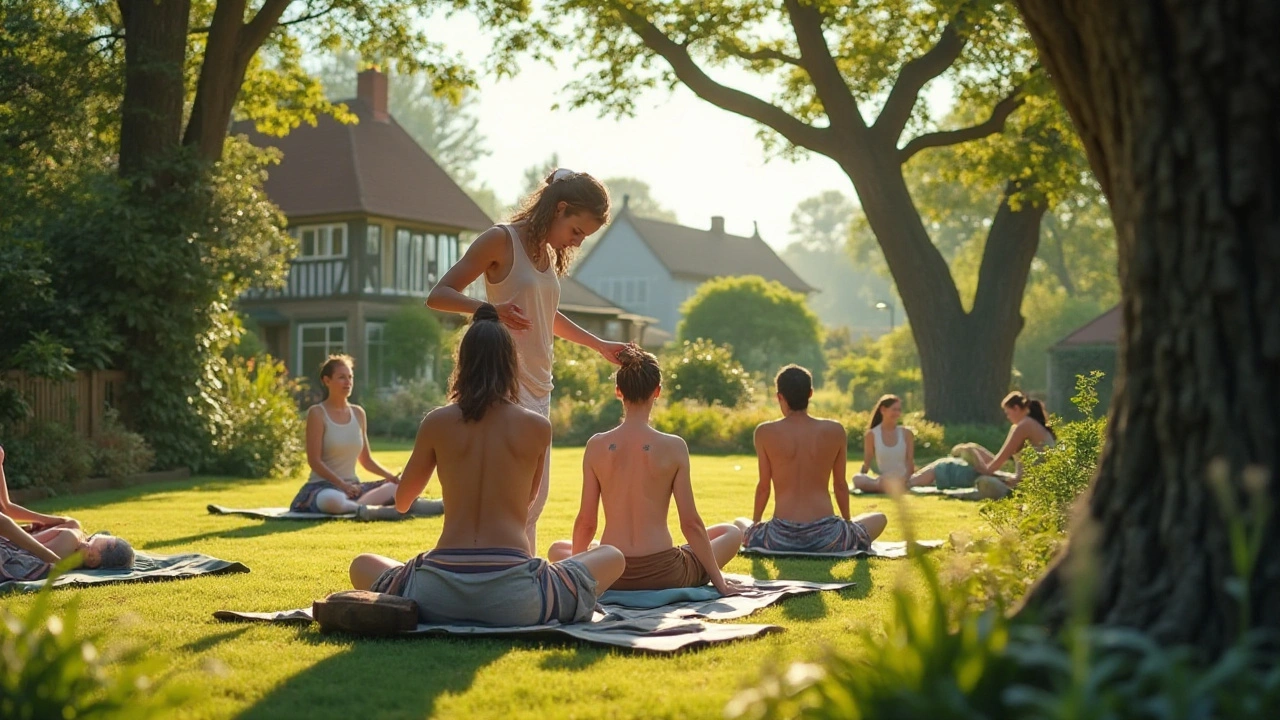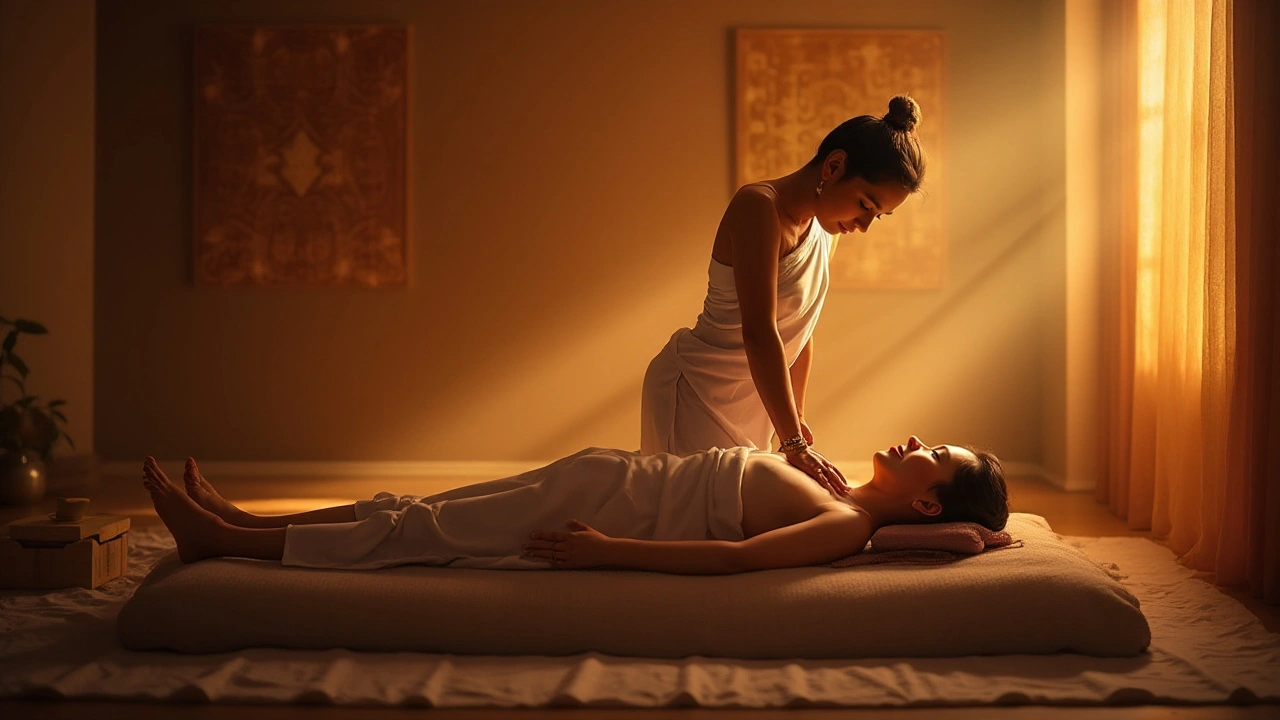Imagine slipping into a state of blissful relaxation, where each breath seems fuller and your body's tension dissolves like mist under the morning sun. Welcome to the world of Thai Bodywork—an age-old healing practice that marries the wisdom of Buddhism, yoga, and traditional medicine to rejuvenate both mind and body. Rooted deeply in the spiritual hinterlands of Thailand, this therapeutic art has been a cherished pathway to health and balance for centuries, embodying a unique symphony of acupressure, gentle stretching, and mindful breathing.
As you explore Thai Bodywork, you'll discover its emphasis is less on a therapist working on you, and more on a harmonious partnership between the provider and receiver. A session resembles a graceful dance, set to the rhythm of your own breath, flowing from one gentle stretch to another, deeply engaging both body and spirit. The beauty lies not just in its ability to relieve physical aches and pains, but in fostering a profound sense of holistic wellness.
If you're curious about enhancing your life and lifting your spirits, learning about Thai Bodywork might just be the key. From understanding its rich heritage and techniques to knowing what you can gain from the practice, this guide will serve as your compass on this fascinating journey towards well-being.
- The Origins and Philosophy of Thai Bodywork
- Core Techniques and Practices
- Health Benefits and Potential Risks
- Incorporating Bodywork into Your Routine
- Choosing the Right Practitioner
The Origins and Philosophy of Thai Bodywork
Thai Bodywork, often referred to as a profound dance of healing, finds its roots entwined with the spiritual and cultural tapestries of Southeast Asia. This ancient practice is believed to have been developed over 2,500 years ago by Dr. Jivaka Kumar Bhaccha, a legendary healer in Buddhist tradition. The art of Thai massage, ultimately a form of healing therapy, is deeply influenced by the teachings and practices of both Buddhism and Ayurveda, offering a unique blend of philosophy and physicality. The origins are shrouded in the mists of time, yet it shares an uncanny harmony with the Indian medical system, reflecting a convergence of beliefs given its geographical proximity.
The philosophy underlying Thai Bodywork is one of balance, both bodily and spiritually. It's thought that life energy, known as 'Prana' in India and 'Chi' in China, flows through the body's pathways, often termed 'Sen' lines. There are over 72,000 of these lines, though the focus is primarily on ten main ones. Traditional Thai philosophy posits that blockages in these energy lines can lead to illness or discomfort, and it's the task of Thai Bodywork to release these blockages through targeted pressures. The goal is not just physical healing but to bring the mind and body into a harmonious state of tranquility. As such, sessions are often conducted in silence or soft-spoken tones, allowing the receiver to focus inward and embrace the holistic benefits fully.
Historically, Thai massage was practiced by Buddhist monks and was regarded as a spiritual practice of healing. Monasteries served as the hub of this knowledge, where the art was passed down through generations of monks. Over time, it became a celebrated part of Thai medicine and culture, although it faced challenges during the modernization of medicine in the early 20th century. A resurgence of interest in alternative and holistic therapies across the globe has propelled Thai massage back into the international spotlight, often hailed for its added emphasis on spirituality and relaxation compared to other types of bodywork.
Modern practitioners of Thai Bodywork continue to honor its traditional roots while also embracing contemporary techniques to meet the needs of today's bodies, often plagued by the strains of modern life. Those experiencing Thai Bodywork will notice a carefully choreographed routine that involves rhythmic pressing, gentle rocking, and deep stretching, each movement thoughtfully calculated to encourage the free flow of energy. Eventually, the process works not only to relieve muscle tension but also fosters a meditative state of clarity. Even if the practice's specifics have evolved, the fundamental principles that Dr. Jivaka espoused—compassion, wisdom, and mindfulness—remain at its core.
"Thai massage is not just a work with bodies but a deeper listening, an listening to the soul," shared Asokananda, a renowned teacher of Thai massage, capturing the essence of this holistic practice.
The commitment of Thai Bodywork practitioners to uphold these time-honored traditions is a testament to the enduring power and healing potential of this ancient practice. Its philosophy speaks to a broader understanding of health, one that unites physical, mental, and spiritual well-being. In a world constantly seeking balance amidst chaos, Thai Bodywork offers a time-tested pathway to a more serene existence.
Core Techniques and Practices
Delving into the world of Thai bodywork means embracing a repertoire of traditional techniques designed to harmonize the body and mind. At the heart of Thai bodywork is a holistic approach that seamlessly integrates physical manipulation with mindful awareness. This practice dates back over 2,500 years and is rooted in the ancient traditions of Thai healing art, where the emphasis is on not just treating symptoms, but fostering a comprehensive balance between spiritual and physical health. The practitioners are often seen as guides, leading you through a series of stretches, presses, and manipulations that work along the body's energy lines, known as 'Sen'. These energy lines are akin to the meridians in Traditional Chinese Medicine, believed to play a crucial role in maintaining health when unobstructed.
The session usually begins with the participant lying on a comfortable Mat, as practitioners use their hands, thumbs, elbows, knees, and sometimes even their feet to unwind tension stored in the muscles and connective tissues. Core practices of Thai bodywork involve rhythmic pressing and stretching of the entire body. This technique requires practitioners to coordinate their pressures with the participant's breathing, almost like a choreographed dance. The process often starts from the feet and progresses upwards, ensuring a gradual release of tension. This artful dance of pressure and release aims at not just physical relief but also unblocking and enhancing the flow of vital life force within the body.
In particular, the practitioner may start with the famous 'palming' technique, applying gentle yet firm pressure using the flat of their palm along the Sen lines. This is complemented by 'thumbing', a more focused technique where the thumb slowly maneuvers through smaller areas needing precise pressure. Following this, assisted yoga-like stretches known as 'yoga for lazy people' are incorporated. These passive stretches are meticulously designed to elongate muscles, improve flexibility, and facilitate deeper states of relaxation. It's a flowing dance of elasticity that coaxes tired muscles back to vitality. For example, a simple spinal twist, facilitated by the practitioner, can invigorate the body's primary pathways of energy and improve spinal flexibility. By the end of the session, what you experience is not just a physical invigoration but a mental clarity rare in today's fast-paced world.
One renowned Thai bodywork expert once noted,
"In every stretch and pressure, there is a beautiful dialogue between the breath and body. It's not just treatment; it's an awakening."This statement encapsulates the essence of Thai bodywork, emphasizing it's about nurturing a connection, a whisper to the internal harmony of one’s self.
For those considering incorporating Thai massage into their wellness routine, it's essential to understand that every practitioner brings their unique touch and interpretation. While one practitioner might emphasize relaxation and gentle pressure, another may focus on therapeutic and energetic work. So when choosing a practitioner, consider your own needs and preferences, ensuring their style aligns with your goals. Through regularly engaging in these practices, you might find yourself experiencing more than just relief from physical discomfort. Many report a profound sense of peace and connectedness as an integral benefit, making Thai bodywork a compelling choice for those seeking a comprehensive enhancement of mind, body, and spirit.

Health Benefits and Potential Risks
Diving into the world of Thai Bodywork reveals a treasure trove of benefits that can significantly enhance an individual’s quality of life. At its core, this ancient practice promotes circulation and boosts the body’s energy. By applying rhythmic pressure on strategic points, Thai Bodywork encourages blood flow and releases built-up tension within the musculoskeletal system. The gentle stretches incorporated in sessions also guide the body towards improved flexibility and alignment, which can lead to reduced chronic back pain and better posture. People suffering from migraines, joint stiffness, and even emotional stress report finding solace after regular sessions. The blending of healing therapy and offered mindful breathing paves a path towards mental clarity and reduces anxiety, which can be a boon in today's fast-paced world.
Additionally, Thai Bodywork stands out by its emphasis on the energetic body channels, traditionally known as 'sen,' akin to the concept of meridians in Chinese medicine. This focus can lead to a balancing of internal energies, fostering both psychological and physiological well-being. However, like any therapeutic practice, it is essential to consider potential risks. Not every technique suits every individual, and it’s crucial to tailor the session based on personal medical history. Certain individuals, such as those with severe osteoporosis, acute inflammation, or cardiovascular concerns, should avoid deep pressure techniques. Always consult with healthcare providers before diving into bodywork, particularly for those under medical supervision.
Engaging practitioners and their skill level remains a significant factor as well. An incorrectly applied technique, particularly by untrained hands, could exacerbate existing conditions rather than provide relief. With that said, authentic and experienced practitioners emphasize the dialogue between client and therapist; understanding the client's needs and discussing any discomfort during the session are integral components. As one practitioner accurately stated,
"Listening to the body is as important as the hands-on work we do."To make the most out of bodywork, consider choosing a practitioner who prioritizes client education, as it empowers receivers with knowledge on their body’s response and recovery process.
Incorporating Bodywork into Your Routine
Embracing Thai Bodywork as a regular part of your lifestyle can pave the way for a serene yet stimulating wellness journey. For many, the challenge lies in breaking through the initial unfamiliarity of the practice itself. However, there's a growing number of enthusiasts finding their footing by starting with short, guided sessions. These offer a gentle introduction to its principles, allowing you to gradually absorb its multiple layers of healing without overwhelming yourself. Think of it less as a rigid protocol and more like a commitment to personal enrichment. Each session is akin to nurturing a delicate flower, with each targeted stretch aiming to unlock deeper layers of stored tension and bring about lasting relief.
Sessions can vary in duration and frequency depending upon your personal goals and constraints. Ideally, you should aim to incorporate healing therapy into your routine at least once a week for optimum results. Whether it’s at a local therapy center or through one of the burgeoning virtual platforms offering online sessions, ensure the environment is comforting. The setting should allow you to breathe freely and let go of the burdens of daily life. This ritual not only offers an escape from the incessant noise of modern living but also invites a newfound clarity to seep into your consciousness. Your bodywork journey is yours to mold, evolve, and cherish.
Crafting a Personal Practice
Adopting a personalized approach can transform the practice from a mere scheduled activity to an intuitive ritual you look forward to. Explore the idea of integrating simple bodywork stretches amid your daily routine, maybe during mid-work breaks or as a wind-down session at the end of the day. Online platforms are abundant with informative videos that simplify this process, offering step-by-step guidance. Crafting personalized routines ensures that the benefits of bodywork infiltrate your life seamlessly, turning it into a lifestyle choice rather than an isolated practice.Consistency is key, and as with any discipline, the more consistently you engage, the more tangible the rewards become. It’s also beneficial to blend bodywork with other complementary wellness strategies. Practices such as yoga, meditation, and mindful breathing exercises beautifully enhance the efficacy of your Thai massage practice. A powerful synergy arises when these are enacted together, placing you on an accelerated path to overall well-being.
Your commitment to this journey doesn't have to be a solo endeavor. Couples or friends pairing up for sessions can deepen their bonds through this shared experience.

Choosing the Right Practitioner
Venturing into the realm of Thai Bodywork is like stepping into an art gallery where each therapist is an artist with a unique style. Finding the right practitioner to fit your needs is crucial, ensuring that your experience is not just therapeutic, but also transformative. Start by considering the practitioner's qualifications and experience. A well-trained therapist typically holds a certification from a recognized institution in Thailand or has significant exposure under a seasoned master. Such credentials reassure you that the techniques employed are authentic and respectful of the tradition's roots.
Word of mouth can be your best guide when searching for a competent practitioner. Personal recommendations from friends or family who've experienced sessions can be more reliable than online reviews. Don’t hesitate to ask prospective therapists about their approach and philosophy. Do they blend multiple techniques for a customized session, or do they adhere strictly to traditional practices? Having this insight can help align your expectations with the received treatment, leading to more satisfying results.
The environment of the massage studio also plays an essential role in your overall experience. A serene, clean, and comfortable setting enhances the therapeutic benefits, allowing you to relax fully and drift away from daily stresses. Pay attention to the atmosphere during your initial visit; this encompasses everything from the aromas used to the ambient sounds.
As Supriya Kaur, a certified wellness coach, aptly puts it, "The space where healing occurs should itself be a sanctuary, echoing peace and tranquility in every corner."
Communication is key in healing therapy, so talk openly with your therapist about your needs and concerns. A seasoned practitioner will ask about your medical history and specific areas of discomfort or tension, tailoring the session accordingly. They should also guide you on how to breathe or position yourself during certain stretches, enhancing the therapy's effectiveness. Always feel encouraged to provide feedback—whether positive or constructive—because it helps your therapist refine the session to better suit your unique health journey.
Lastly, trust your intuition when selecting a practitioner. Your comfort and sense of safety are paramount, and a strong rapport often signifies you’ve found the right fit. There's a deeply personal connection that develops with the right therapist, which can be as healing as the work they do. Remember, embarking on the path of Thai Bodywork is not merely about fixing aches but nurturing a lifestyle that's attuned to holistic well-being.

